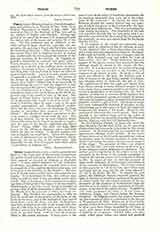

Tissot, JAMES (JOSEPH-JACQUES), French draughtsman and painter, b. at Nantes, October 15, 1836; d. at Buillon, Department of Doubs, August 3, 1902. He studied at Paris at the Academy of Fine Arts and in the ateliers of Ingres and Flandrin. During this period of his career he became well acquainted with the darker side of the moral and political life of the city. The first paintings that he exhibited at the salon attracted great attention, especially the one picturing the meeting of Faust and Gretchen, now in the Luxemburg Museum. When the Commune came into power Tissot fled to England for fear of coming into conflict with the Government on account of the political intrigues of his brother. In England he gained a reputation as a portrait and genre painter. Tissot, however, was more of an illustrator than a painter, as is shown in the brilliant series of watercolors, “La femme à Paris“, in which in careful, correct work done with much dash he lashed the follies of modern Parisian life. Later he issued a similar series of aquarelles on high life in London. The picture of the former of these series entitled “La femme qui chante dans l’église” obliged him to go repeatedly to church during the service, and this suggested to him the conception of the picture, “Christ Appears to Console two Unfortunates in a Ruin”. With this last-mentioned work a new epoch began in the life of the painter and, in the course of time, of the man. The figure of Christ had so attracted him that he was never afterwards able to put it out of his mind. He went to Palestine where he spent a year in the most careful geographical and ethnographical studies. After this he spent ten years in preparing the large number of aquarelles that compose his “Life of Christ”. The absolutely modern conception of this work shows a complete break with the past. The work was entitled “La vie de notre Seigneur Jésus-Christ, 865 compositions d’après les quatres évangiles, avec des notes et des dessins explicativs, par James Tissot” (Tours, 1896). The price was high, 5000 francs for the edition on Japanese paper, and 1500 francs for that on vellum. A cheaper popular edition in English was issued later. Tissot also designed a series of illustrations for the Old Testament, which, however, are not as fine as the earlier ones. The aquarelles on the New Testament have been called “a revolution in religious art”.
BEDA KLEINSCHMIDT

